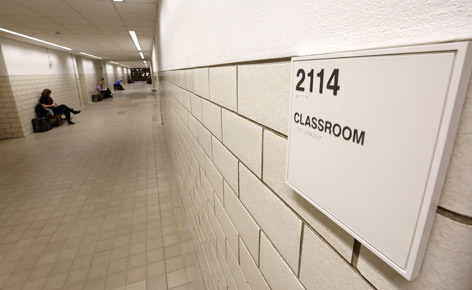
All 11 general university classrooms on the second floor of Pearson Hall will be renovated as part of a new classroom improvement initiative. Photo by Christopher Gannon.
Spurred by enrollment growth, aging buildings and innovations in teaching methods, the university has embarked on a plan to upgrade all 214 general university classrooms on a 10-year cycle. The effort will be financially supported every year with $500,000 from the office of the senior vice president and provost and $250,000 from facilities planning and management. Other partners – primarily departments and colleges that most use specific classrooms – will match those funds each year of the renovation program.
The Student Experience Enhancement Council, faculty senate and academic department chairs all have identified classroom upgrades as a priority, and last month the first significant project was approved by President Steven Leath and the Capital Projects Advisory Committee.
"I'm not sure any university is more efficient in its use of classrooms than Iowa State, and that's a great credit to our faculty and our facilities and scheduling professionals," Leath said. "This initiative will upgrade every general university classroom to better meet the specialized needs of faculty and our academic programs."
Pearson Hall
"We'll be making impactful changes to 214 rooms over the next decade," said senior vice president and provost Jonathan Wickert. "Smaller projects – for example, lighting improvements or seats replacement -- already are occurring, and the first significant renovation will modernize all 11 general university classrooms on the second floor of Pearson Hall."
Pearson is a 53-year-old facility. Associate vice president for academic planning and resources Ellen Rasmussen estimates the second floor renovation will be a two-year project, with the rooms out of use for about 16 months. The next steps, she said, are to hire design professionals and seek input from faculty in departments using the Pearson classrooms about what capabilities and features are needed. Upgrades could change the mechanical and lighting systems, room finishes, furniture and instructional technology, and create better uses for corridor spaces or alter the size/capacity of rooms. Ten of the classrooms currently have seating capacities between 34 and 40 students; the 11th room seats about 100 students.
In addition to the provost's office and FPM, units providing funds for the project are the College of Liberal Arts and Sciences and information technology services. Rasmussen said actual contributions will be determined once detailed cost estimates are known.
A steering committee for the project will include representatives from the LAS college, ITS, FPM, the provost's office, room scheduling and the Center for Excellence in Learning and Teaching.
How does it rate?
Students and faculty assess the helpfulness of a classroom renovated to promote active learning.
Phased projects
Rasmussen said the classroom improvement initiative will intentionally include projects of varying durations and price tags. She said the intent also is to distribute them across campus and to mix in rooms of different sizes. Above all, a steering committee will need to coordinate these projects with other building projects – for example, the Marston Hall renovation – to keep as many classrooms in use as possible during any given semester.
Iowa State made other big investments in classroom improvements in the last dozen or so years -- $14 million from the state Legislature in FY03-06 and $2 million in federal stimulus funds in FY10, for example – but Rasmussen said several things make this approach different:
- Faculty will have input to the renovation projects
- Funding is internal and ongoing, not one-time
- Multiple ISU units will partner on each project
The primary focus of the 10-year plan is on renovating existing classrooms, but Rasmussen said the hope is that the process also will uncover some under-used spaces that could be added to the university's inventory of classrooms.
"When you raise general awareness about space, one of the outcomes could be that you pick up some good classroom spaces," she noted.
Classroom planning study
A continuing 10-year cycle for improving all general university classrooms was among the recommendations in a classroom improvement study completed for Iowa State in February 2014 by the Des Moines-based consultants INVISION. Others included:
- Create more work and study spaces outside classrooms for small group work and conversations
- Develop a culture of matching appropriate classes and classrooms, which could reduce incidents of faculty teaching back-to-back in the same room
- Develop a single help desk for real-time, on-call assistance to faculty, whether a request is related to IT, maintenance or teaching support
- Prioritize 75- to 150-seat classrooms for upgrades (they're the most used and the most in-demand)
- Include more general university classrooms in future building projects
The consultants' work included focus group discussions with both faculty and students, a thorough assessment of 48 classrooms, review of all 214 general university classrooms, analysis of classroom use data from the fall 2012 and spring 2013 semesters, and comparisons with current trends in higher education. The consultants noted that Iowa State could improve its classroom capacity three ways: increase room use, increase the number of seats filled per room or add classrooms – or some combination of the three.

